The Easiest Way to Remove Paint from your Old Wood Furniture
Look at what was underneath 3 layers of chipping old paint! Let’s dig into the whole process of how to remove paint from wood furniture so you can show off the beautiful natural wood again.
This dresser makeover started with stripping / removing the paint from the wood. When we stripped off the paint, we found some stunning raw wood underneath, and just had to keep it natural! Get more refinishing furniture tips here!
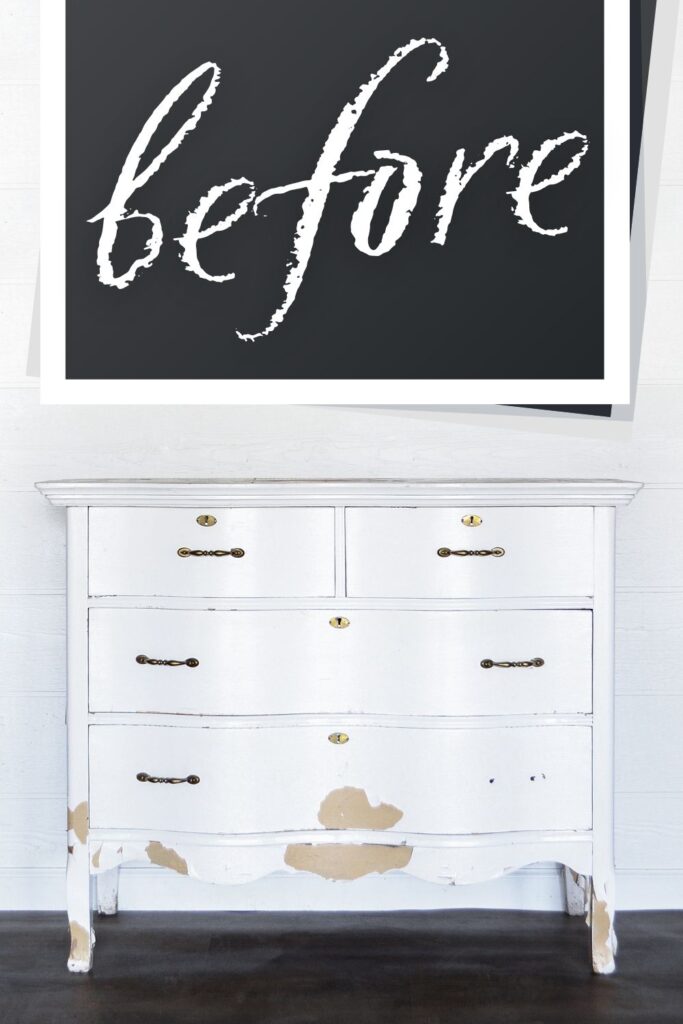
Our client brought us her Grandma’s old dresser that has been in her family for over 100 years! And there were at least 3 layers of paint on it when it made its way to me.
The original plan was to give the dresser a fresh new layer of dark grey paint. But the old finish was in really bad shape.
So we planned to strip off the old paint to give the new paint a good solid base. That was the plan. Until we saw what the wood looked like underneath.
Let’s go through the steps to remove old paint or stain from any type of wood furniture. That includes wood veneered furniture just like this one too.
Then we’ll finish up the process by keeping the wood natural with a few tips.
Supplies Used To Remove Paint From Old Wood Furniture
As an Amazon Associate, I earn from qualifying purchases. I also may earn from other qualifying purchases with other companies or get free product to review and use. All opinions are my own.
- Lead Paint Testing Kit
- Citristrip
- Gloves
- Cheap Paint Brush
- Plastic Wrap
- Scraper
- Mineral Spirits
- Steel Wool
- Scrubbing Pad
- 220 Grit Sandpaper
- 400 Grit Sandpaper
- Power Sander
- Shop Vac
- Tack Cloth
- Waterbased Polyurethane
- Paint Sprayer
- Wax
Grab our list of 10 must have painting furniture supplies too!
How to Test for Lead Paint
It’s a super simple process, but it’s super important to know if you’re working with lead-based paint. Lead is toxic and can make you sick if it’s not removed properly.
So if you’re working with lead-based paint, it’s best to remove it with a chemical stripper (like we did) instead of sanding it off.
You can find these little lead paint testing kits at your local hardware store. (I pick mine up from Home Depot a lot).
The test is easy as squeezing the two ends of the lead tester, shaking it to mix the liquids, and then rubbing that liquid onto all of the layers of paint.
Check out this post for step-by-step info on how to use this lead paint test kit.
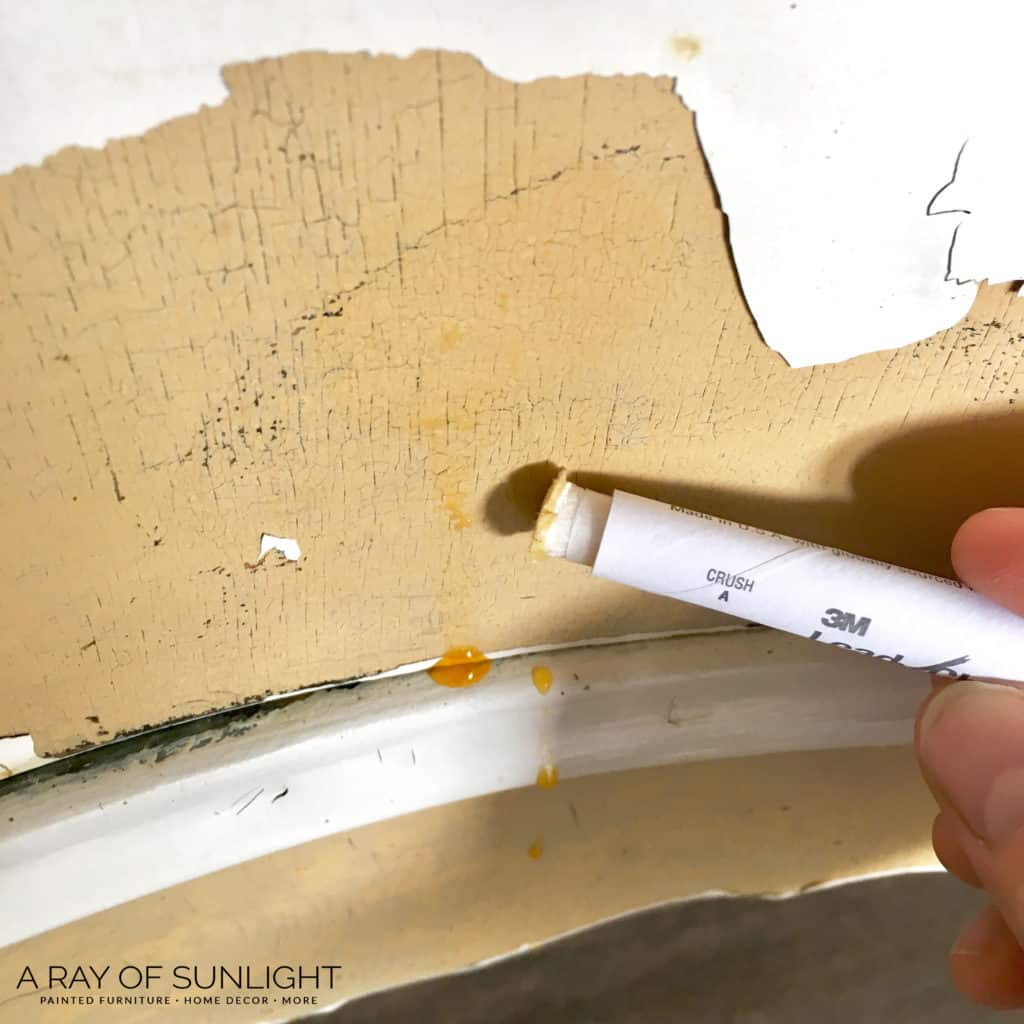
If it turns red or pink, then you have lead in your paint. If the liquid stays a yellow-orange color, then you most likely don’t have lead in your paint.
If you only see yellow or orange, test it on the little confirmation card to make sure the liquid in the tester is working correctly.
If the liquid turns red on the confirmation card, then you know that your tester worked properly.
We tried this lead test out on this dresser and found a mix of results. The white paint didn’t have lead in it, but the layers underneath did. (Paint used before 1978 most likely has lead in it.)
So since we knew we were working with lead paint, we knew better than to start sanding the paint to remove it.
If the old paint is chalk paint, here’s how to remove chalk paint easily and quickly. Or, check out my post on how to paint over chalk paint here.
How to Use Citristrip Stripper
Our favorite way to remove paint or stain is to use this chemical stripper called Citristrip. It isn’t harsh like a lot of strippers are.
Check out the best wood stain removers to learn more about the benefits of each product.
In fact, it actually smells good! And most importantly, it works time and time again. But I have a little extra trick when it comes to using Citristrip to remove paint or stain from wood. (See step 2)
Safety first! Put on some nice thick chemical-resistant gloves to protect your hands… and some eye protection is nice too.
Also, it’s best to use this stripper outside, but you can totally use it inside too with some windows open for ventilation.
Check out the low VOC and less toxic stripper I used in refinishing a dresser here! Here is my list of the best tools for removing paint.
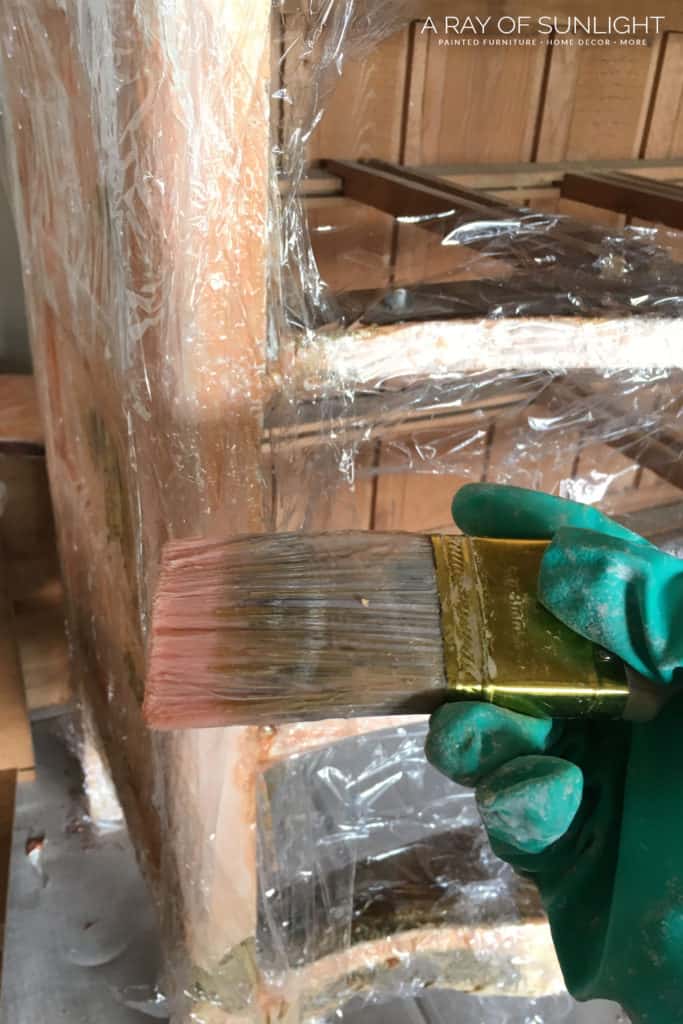
You really want it to be thick. I usually dump it out of the container onto the top of the furniture. Then I just move the stripper around with the paintbrush until it’s everywhere.
Also, the stripper will eat up foam brushes in a second. So I like to use a cheap chip brush or a dollar store paint brush.
And then *here’s the little trick I use to make it work even better*: I cover the Citristrip with plastic. No joke. I personally like to use plastic wrap or garbage bags. But the plastic makes the stripper work for longer.
Then it’s time to walk away.
Walk away, go to bed, work on other projects, run errands. Do what you need to do. But don’t mess around with it for at least 8 hours. But it can sit for up to 24 hours too.
*Update* – Citristrip has changed its formula. I now find myself letting it sit for a little longer with no problems. It doesn’t dry out as fast anymore.
So, just leave it. Just let it do its thing. A sign that it is ready is when it is really wrinkled up like the stripper sucked up all the paint and then started to dry.
Removing Stripper and Paint
For furniture with detail (surfaces that a flat scraper can’t reach), use an old toothbrush, toothpick, or (no joke) even floss to get into tight details and corners.
Get more juicy details on how to remove stain from detailed wood or another post and video on how to remove wood stain from furniture legs here.
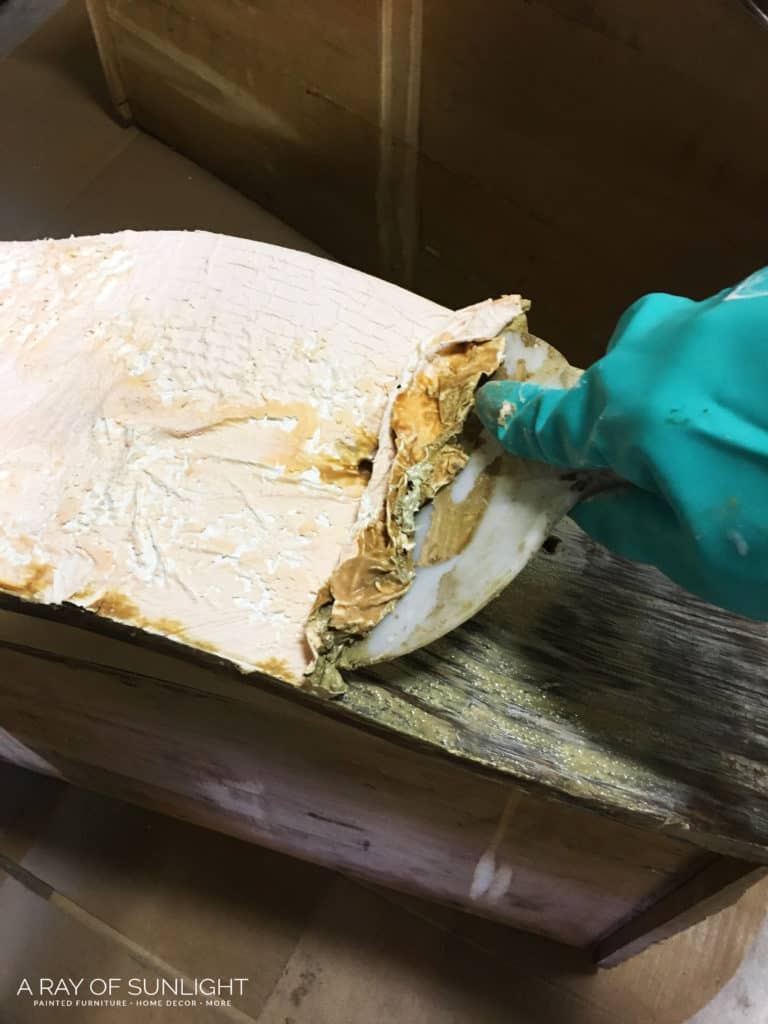
I scrape all of the stripper and paint into empty and clean plastic containers like sour cream, cottage cheese, pasta sauce, etc. containers. I like having something that has a wide opening and that has a lid.
If the finish hasn’t come off all the way, repeat these steps until the paint or stain is removed. It usually takes 1-2 rounds for me.
There will always be some gunk or residue left over that needs to be washed off.
How to Remove Citristrip Residue
I typically use mineral spirits (poured into a plastic bowl) and some fine steel wool to scrub off anything that is left.
The mineral spirits really helps loosen some of the old finish, and the steel wool scrubs it away.
You can also use a scotch-brite scrubbing pad with the mineral spirits. It doesn’t work as well as the fine steel wool though.
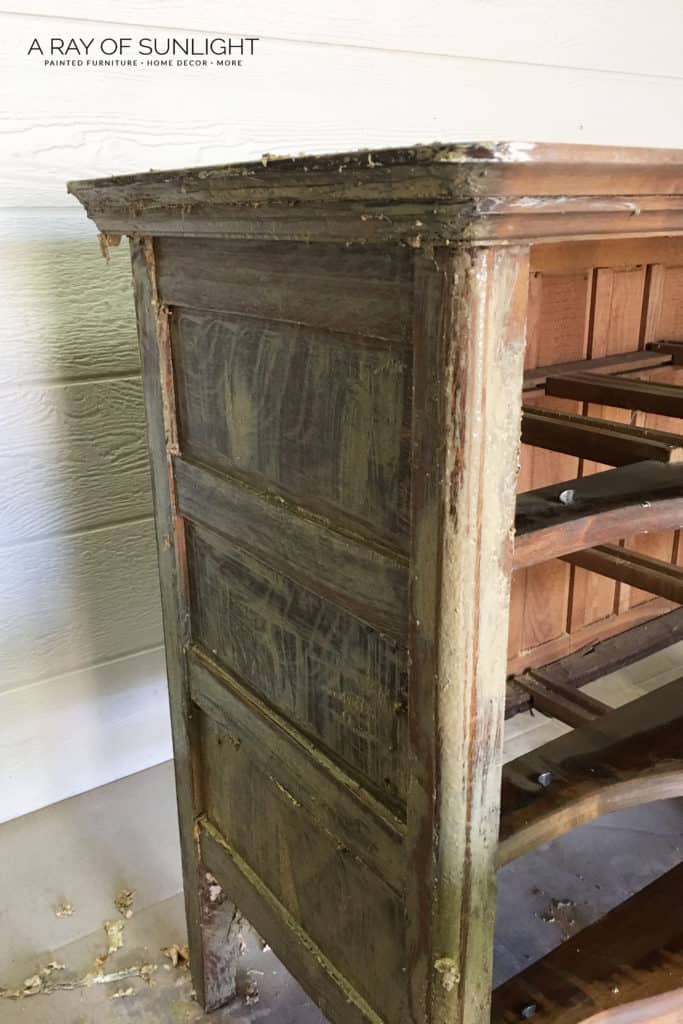
For the tight areas, corners, or details, use the old toothbrush and toothpick to get the gunk out of the details.
And as you scrub off the remaining gunk, replace your scrubbing pad as it gets too much gunk on it. You want to get that wood all clean and fresh.
At this point, the freshly stripped wood will be very wet and saturated. I usually go over it a few times with paper towels to wipe up as much liquid as possible.
What To Do After Stripping Paint From Wood
And then it’s time to let the wood dry completely. I usually leave it alone for a day or two, depending on the weather and humidity.
Learn more from our tutorial on how to strip paint from wood furniture.
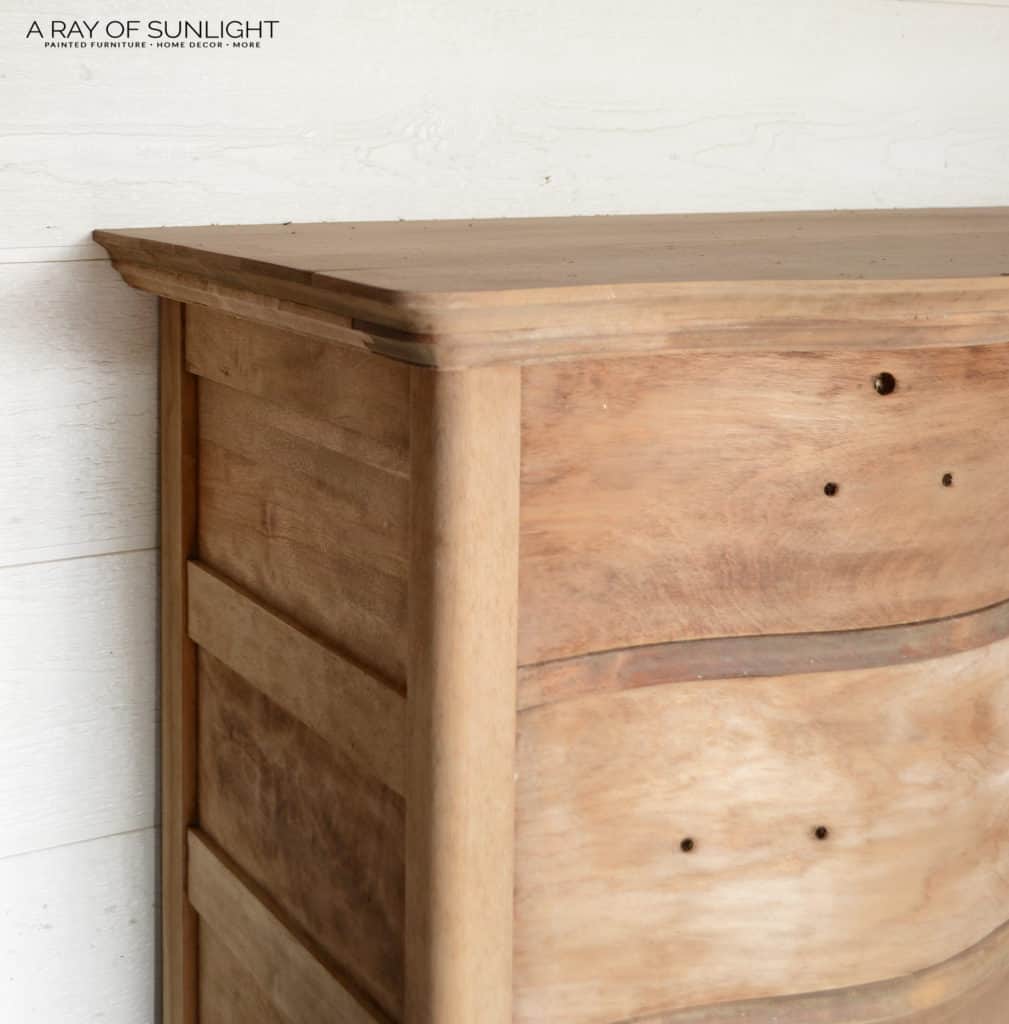
This is what the dresser looked like once it was dry. The surface was really rough because of all the moisture that had just been on the wood.
So before I did anything else, I sanded the wood with 220 grit sandpaper to smooth it down. Learn more about the best sandpaper for furniture here.
Now at this point, you could totally prime and paint the wood again. That’s actually what the original plan was.
But once we saw the beautiful wood underneath all of that paint, we decided to stick with a wood finish.
Check out my guide on how to sand down wood here.
How to Seal Raw Wood Without Changing the Color
The trick with a raw wood finish is that it needs to be sealed. But once the raw wood is sealed, the color of the wood darkens, and sometimes it gets an orange tint to it.
Check out how to tone down orange wood furniture here.
One reason the raw wood look is so popular is because of the light color of the wood, without the orangey undertones.
Sanding After Stripping Paint
We really wanted to make the wood grain look as good as possible so we fixed those issues with a couple of simple tricks.
We grabbed more 220 grit sandpaper and really worked on getting the wood grain to be even and to remove any “water” stains that the stripper and mineral spirits had left.
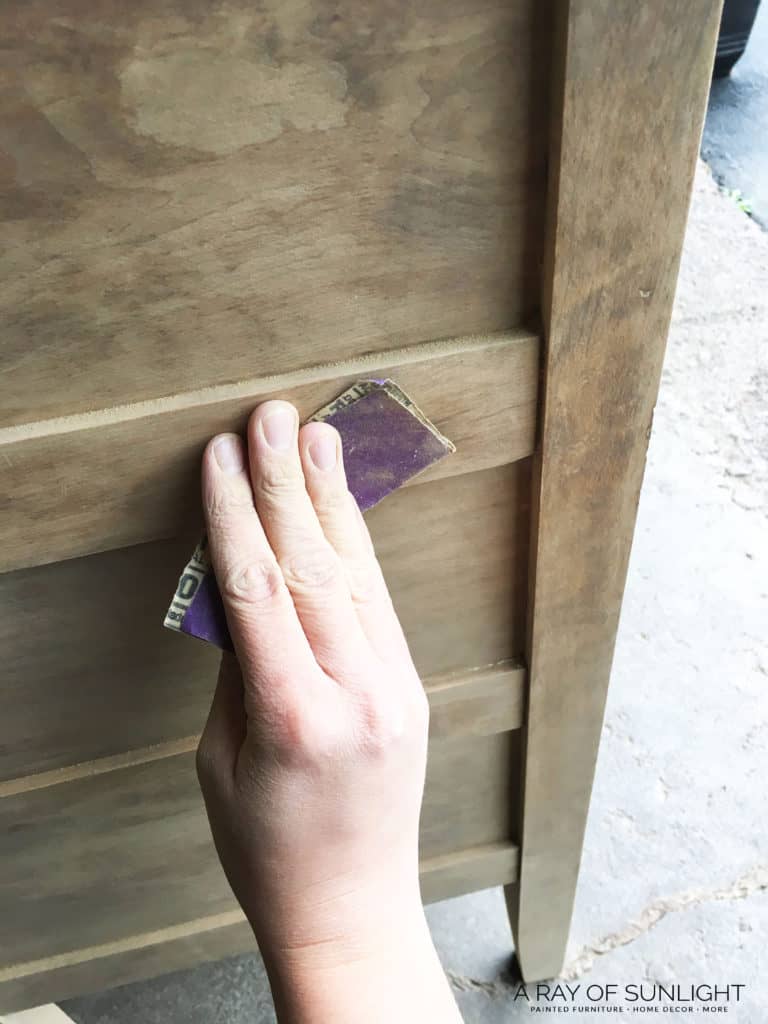
On the flat areas, we used our power sander to really get the wood grain to shine. Check out the best sanders for furniture here.
This piece of furniture was made with wood veneers though, so I was very careful with the power sander to not sand too hard.
When the wood was as smooth and fresh as possible, I went back over the whole dresser with 400 grit sandpaper. The 400 grit is really fine and creates a super super smooth finish.
Then I removed all of the dust with my shop vac and tack cloths. I like to put the brush attachment onto the hose of the shop vac to brush the dust into the vacuum.
The brush really helps with the corners and details… and the flat surfaces. Basically all over! haha And if you haven’t ever used tack cloths before, you NEED to!
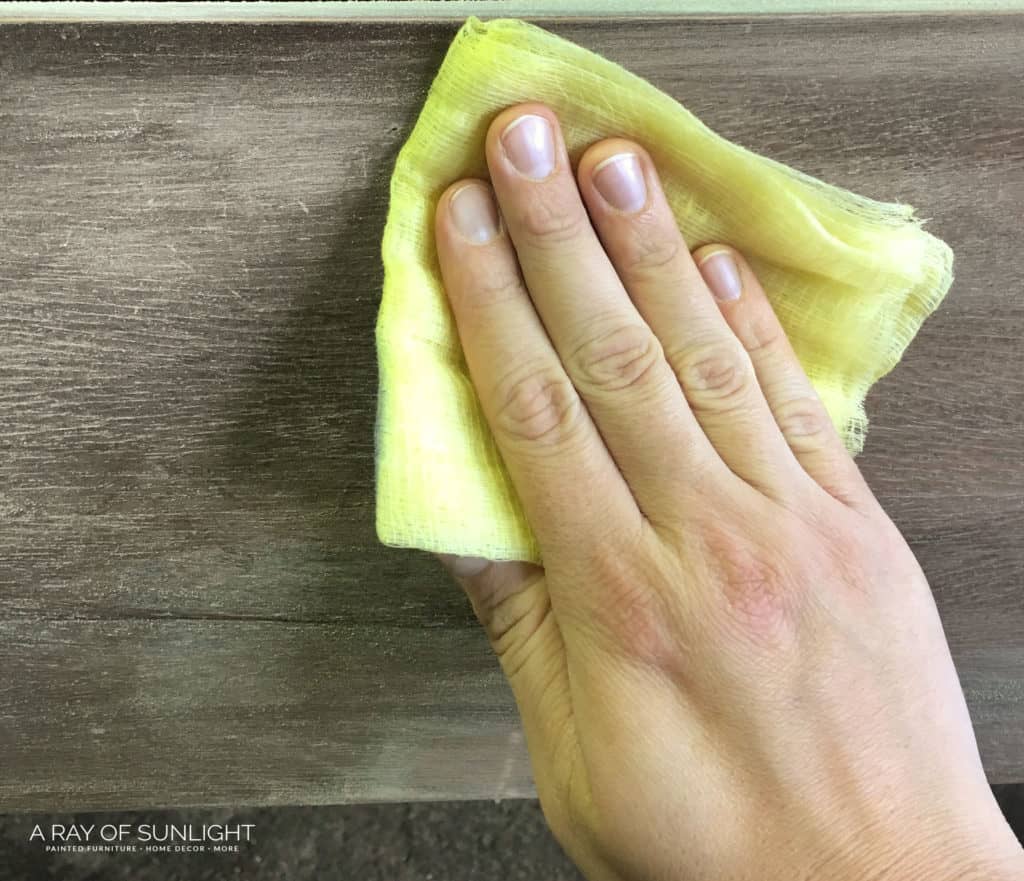
They are really tacky (kind of sticky), so they do a really good job of picking up any leftover dust. They work great on painted furniture too and can be used a few times before needing replaced.
Seriously. I used to use lint-free rags and thought that was good enough. But these tack cloths are my new favorite tool for refinishing furniture.
After you have sanded or stripped, if the wood is still not very light, you can bleach the wood to make it lighter! Check out this post on how to bleach wood, to see how homemade bleach can make wood lighter!
Sealing Raw Wood
It’s super important to use a water based poly for this. I love to use Varethane polyurethane on my furniture projects! It’s super durable and is easy to use!
If you use an oil based poly, the wood will really start to amber and have orange tones to it. And over time the oil based poly will amber way more than water based poly will.
The best way to apply the poly is with a paint sprayer. Make sure to apply 3 coats of poly on the wood.
Learn ALL of my tips and tricks on how to spray polyurethane here! Here’s my list of the best HVLP paint sprayers for beginner and intermediate furniture painters.
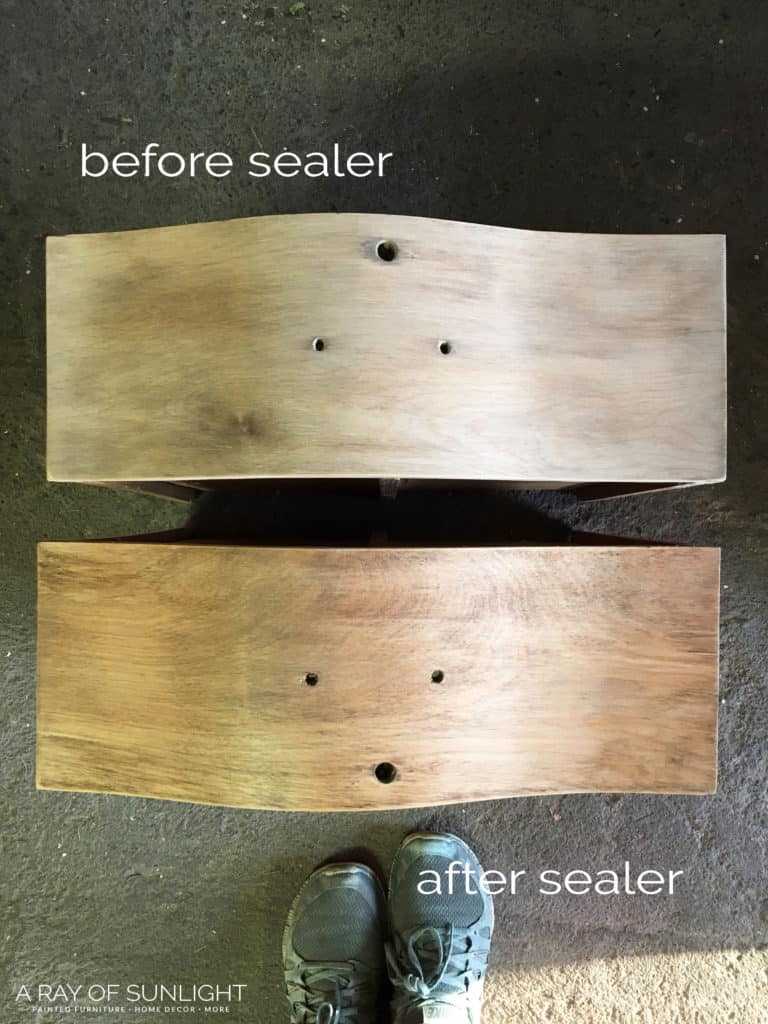
To make sure the last coat of poly left a super smooth finish, I gave the dresser a light sanding with 400 grit sandpaper.
And of course, I vacuumed and wiped off the dust with a tack cloth again before applying the last coat of poly.
How to Use Liming Wax
Once the poly was completely dry, I applied a really light coat of a white wax. To make your own colored wax, just mix 3 parts clear wax with 1 part of your paint of choice.
Denise at Salvaged Inspirations has a great little post all about tinting furniture wax with paint.
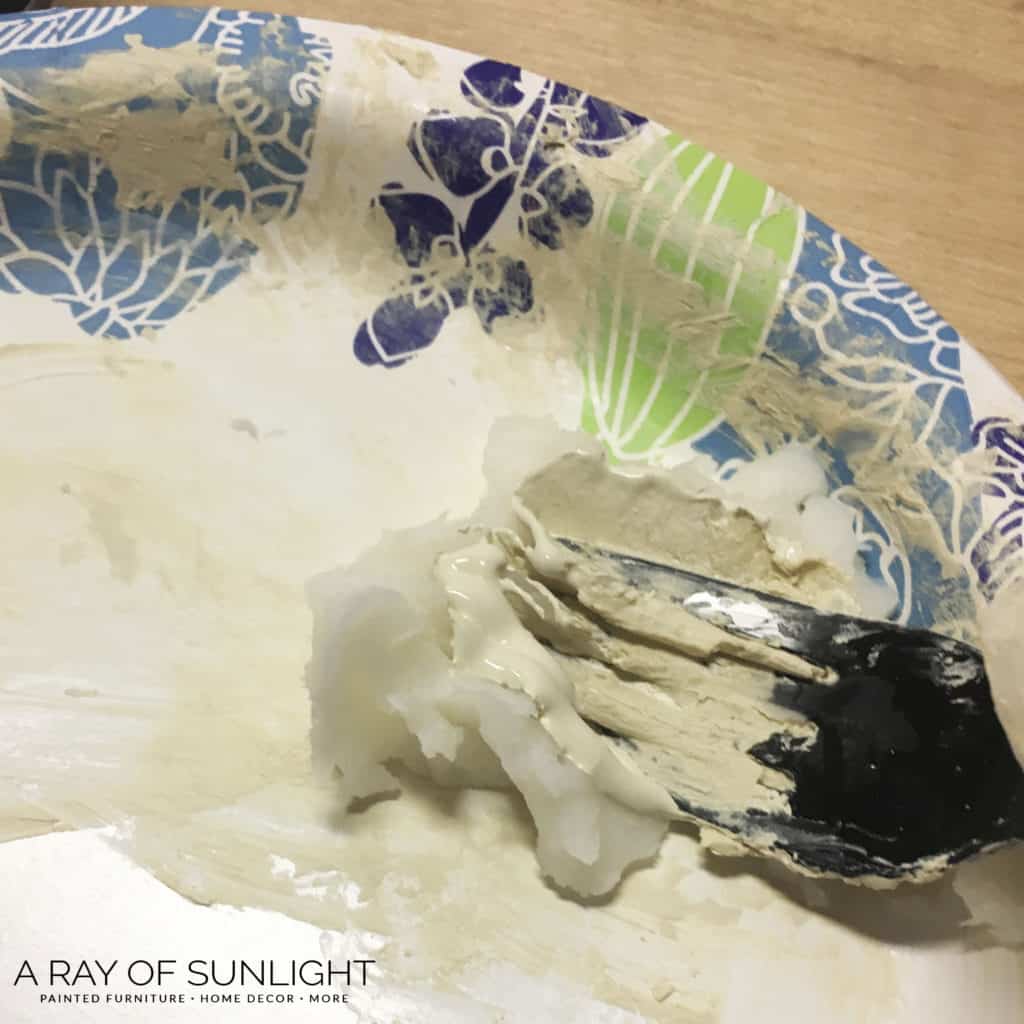
I actually chose to mix in a cream paint instead of a white paint.
I wanted the wax to recreate the color of the raw wood before it was sealed. And I felt like the pure white would be too bright and too much of a contrast.
Then I used part of an old t-shirt to rub the wax onto the sealed wood. Once the wax was dry, I buffed out the wax with another t-shirt rag.
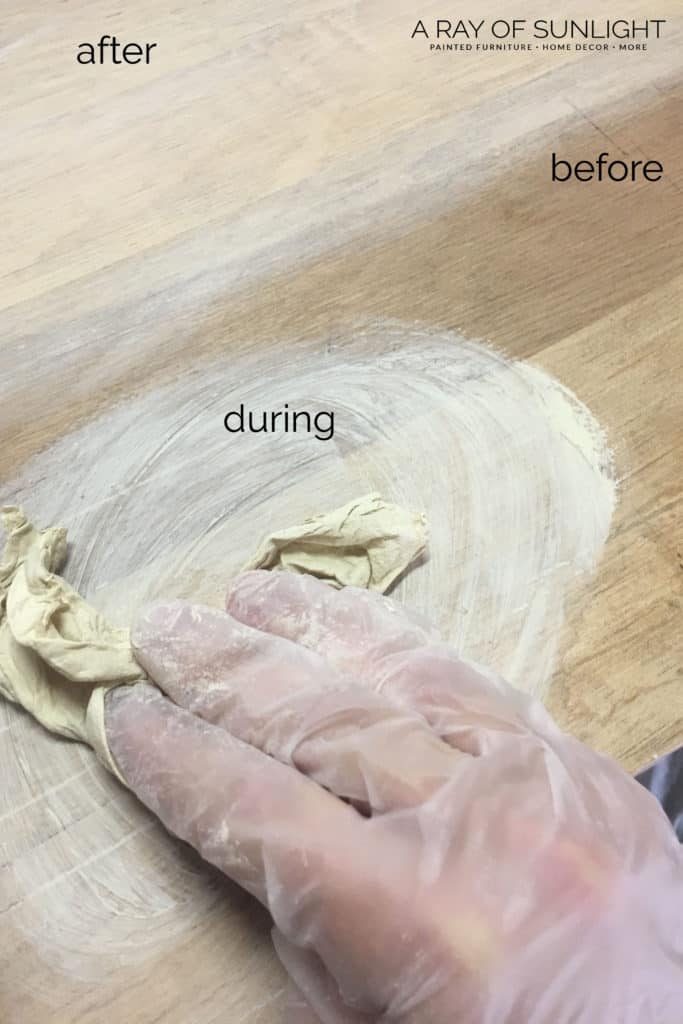
You can also whitewash instead of using liming wax. Learn about how to whitewash furniture in this post.
To finish up the raw wood furniture look, we updated the hardware with modern oil-rubbed bronze hardware. Here’s more on how to change hardware on furniture.
There you go! Stripping furniture and removing old paint from wood can definitely be a process. But I think it’s a process that is worth it. Especially when you find beautiful wood underneath and are able to show it off.
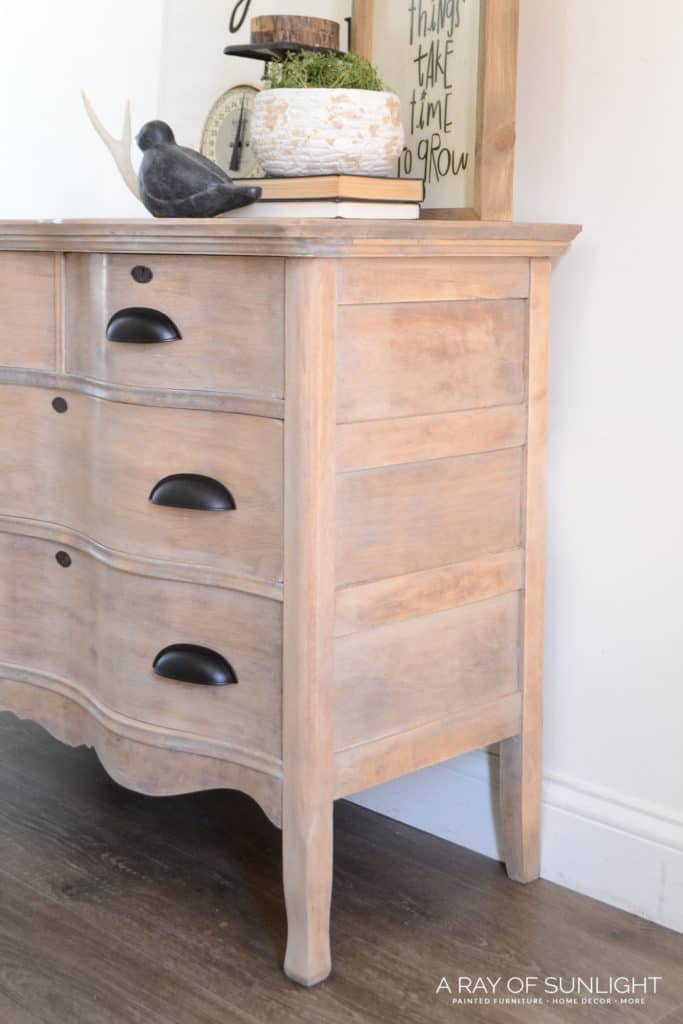
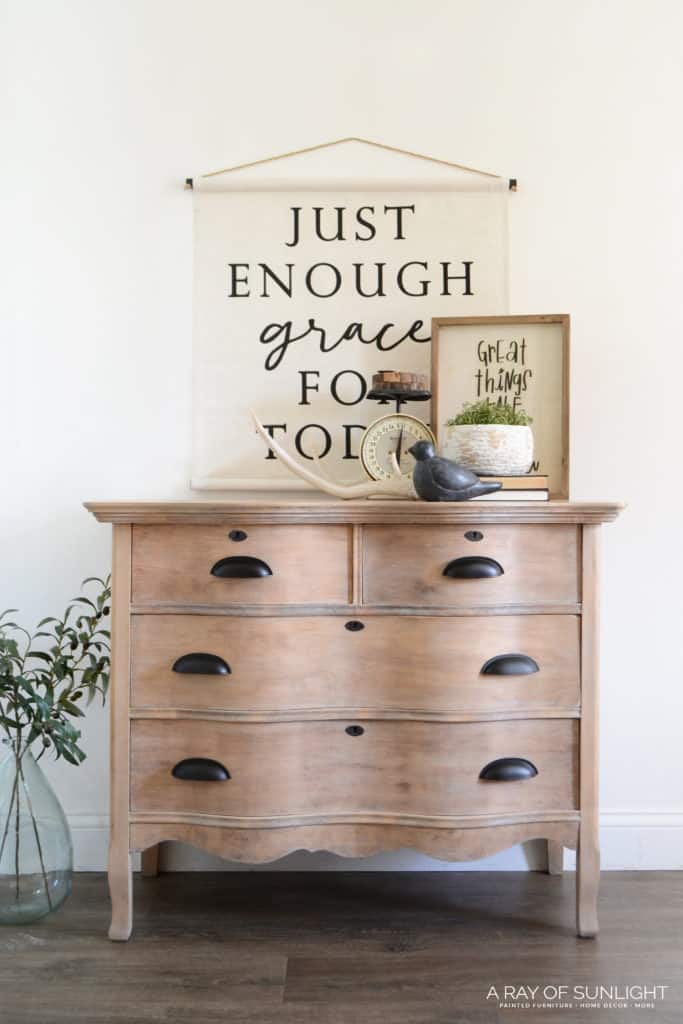
More Before And After Makeovers
Click any of these “before” photos below to view the “after” of that makeover.
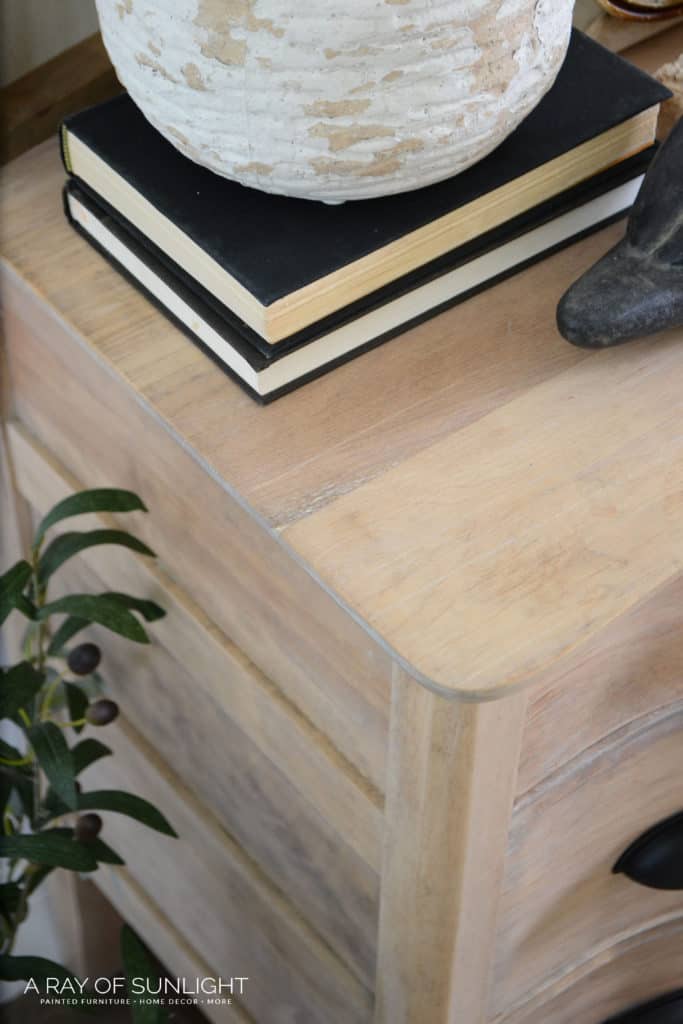
More Raw Wood Makeovers
- DIY Whitewash Dresser
- Refinishing an Old Dresser
- Coffee Table Makeover Idea
- Buffet Turned Into Bathroom Vanity
- How to Strip a Kitchen Table
Follow us on YouTube to get more tips for painting furniture.
Or share your project with us on our Facebook Group and be part of our community. See you there!

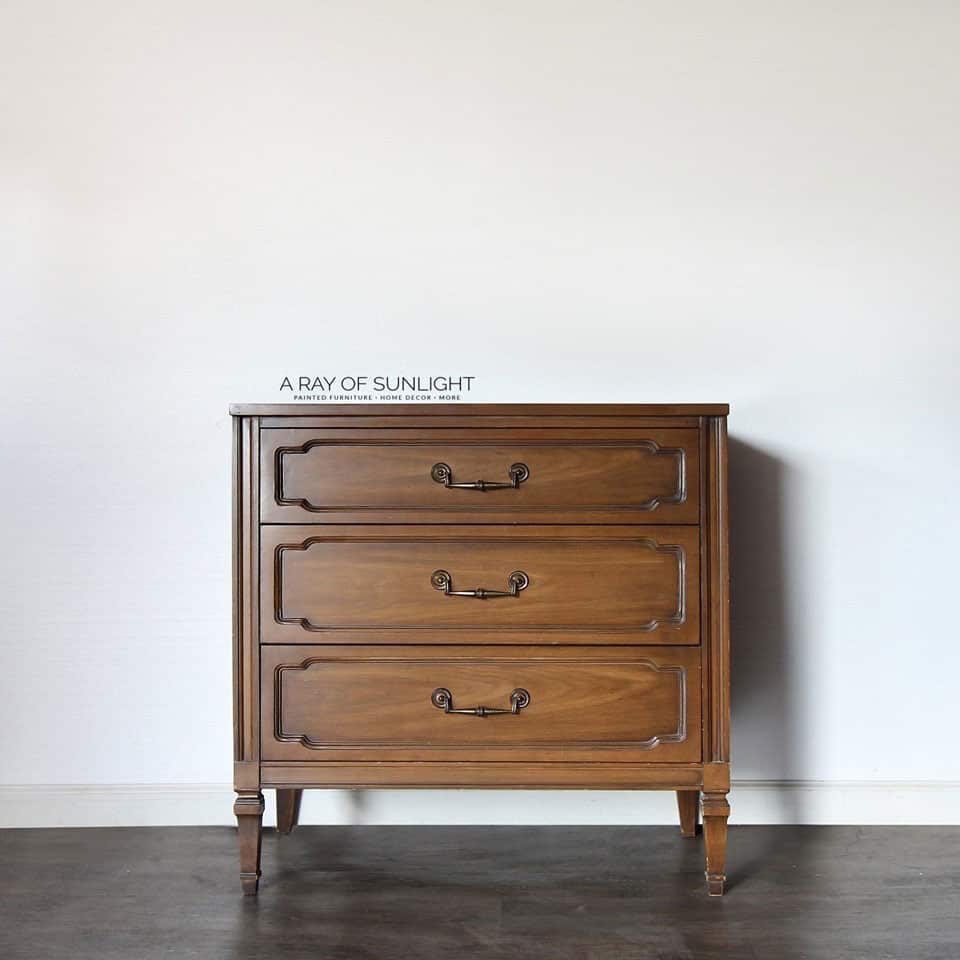
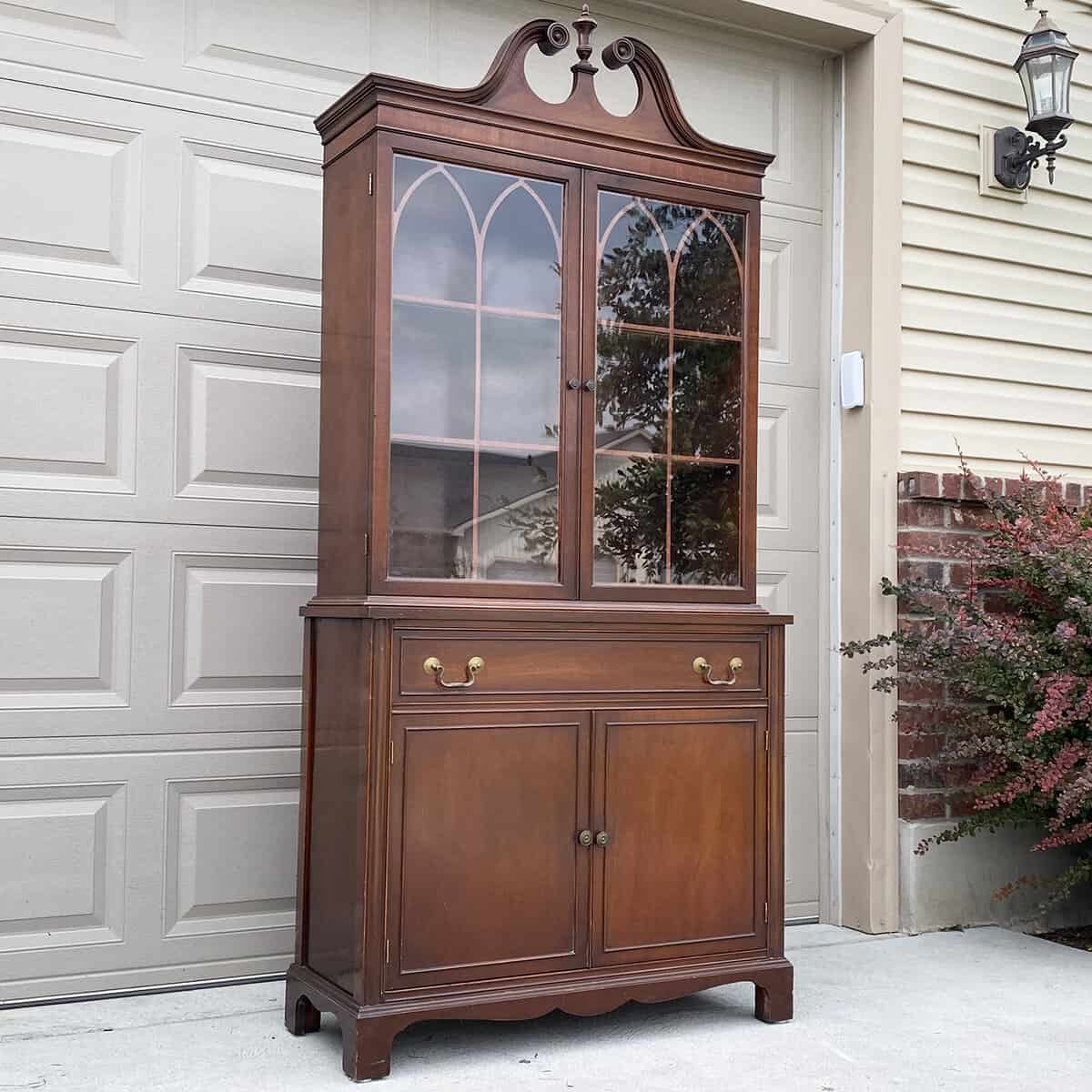
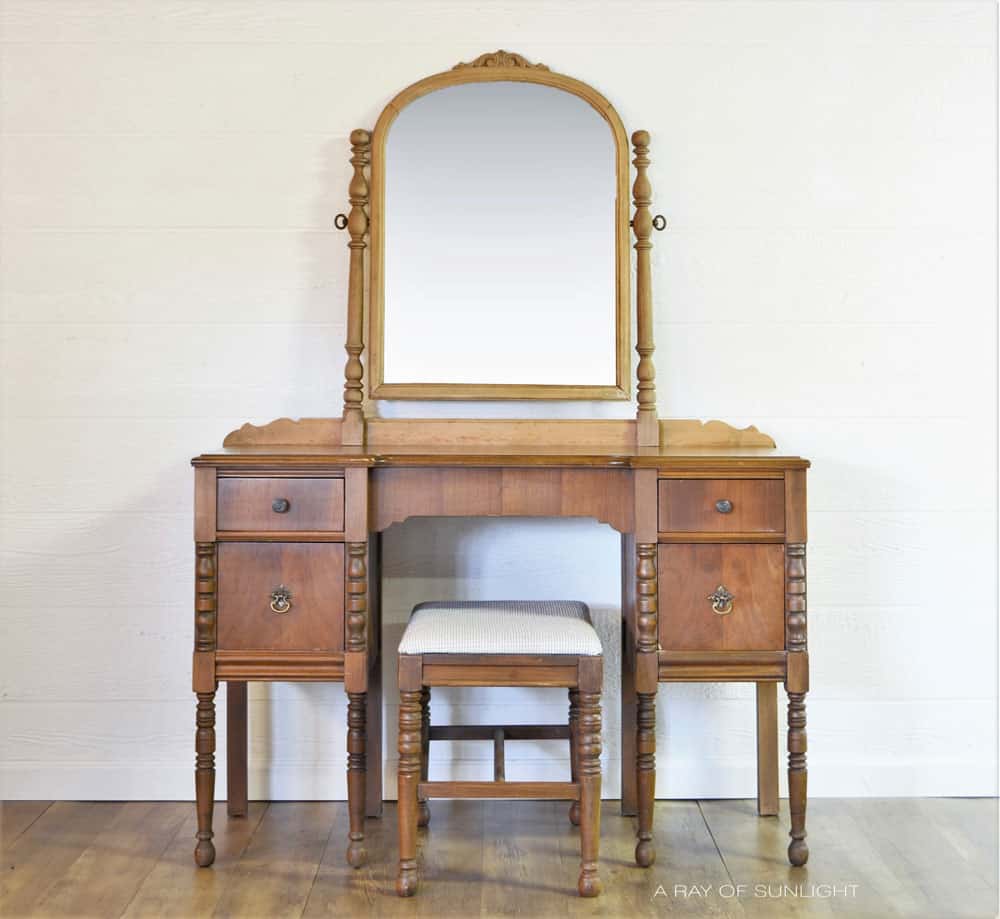
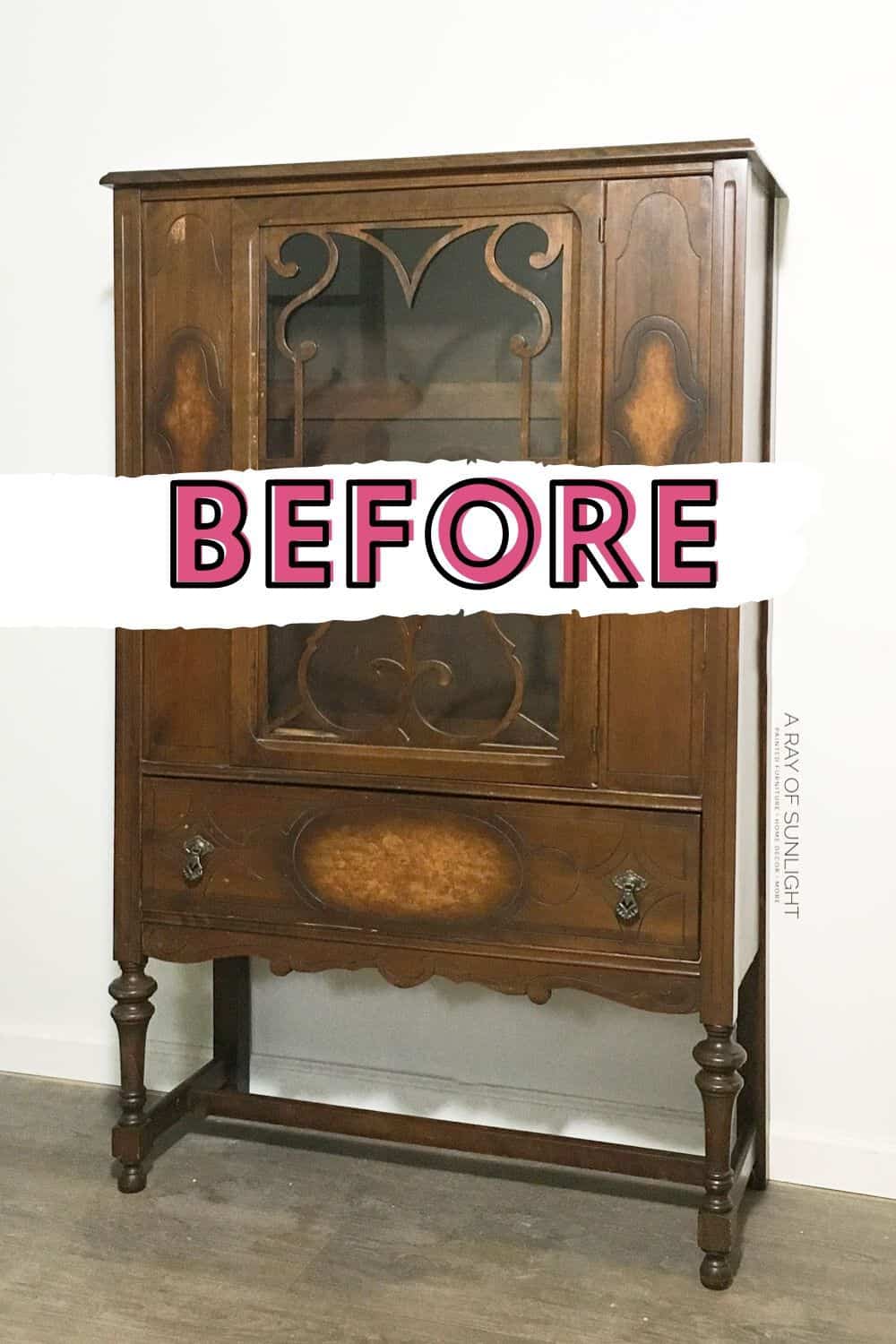
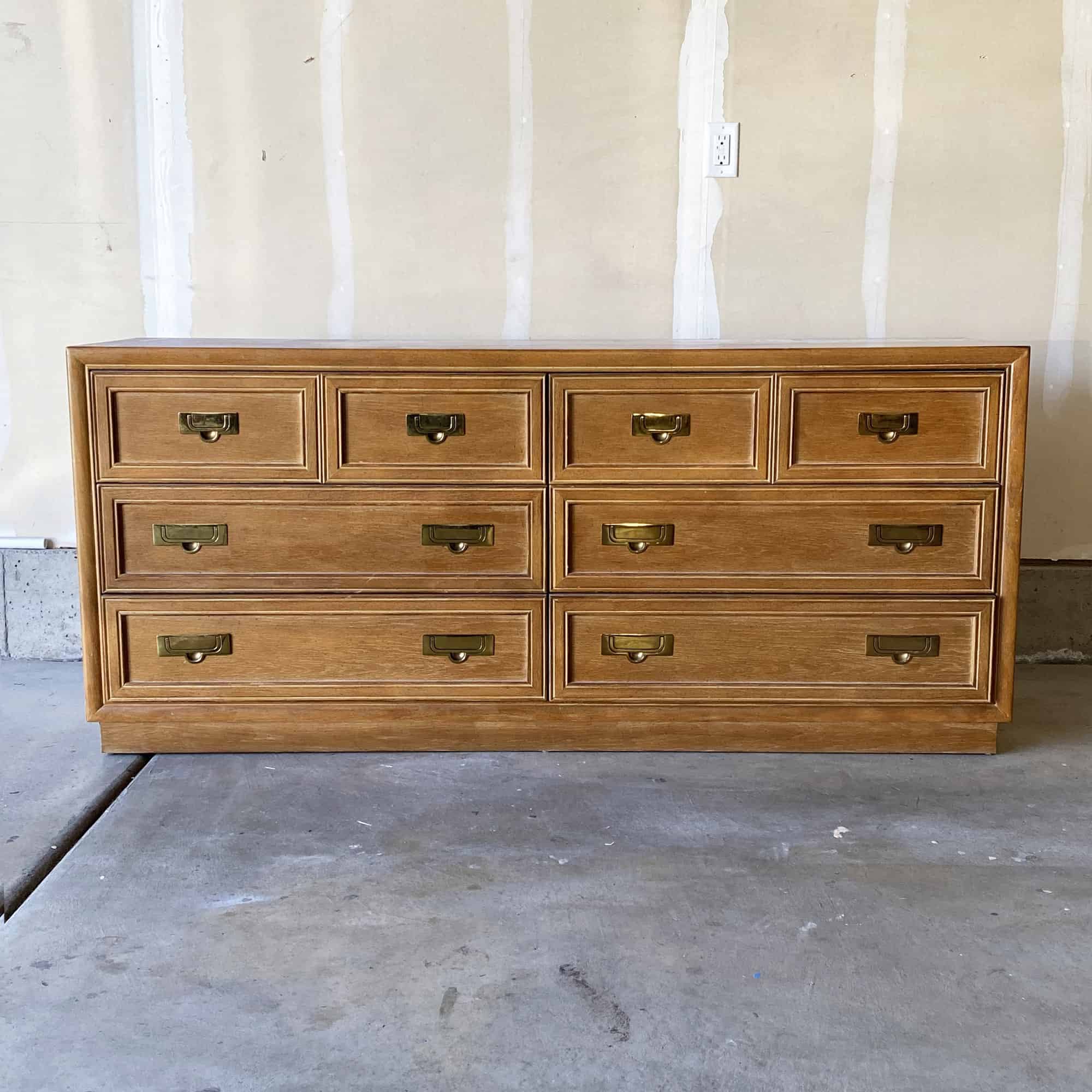
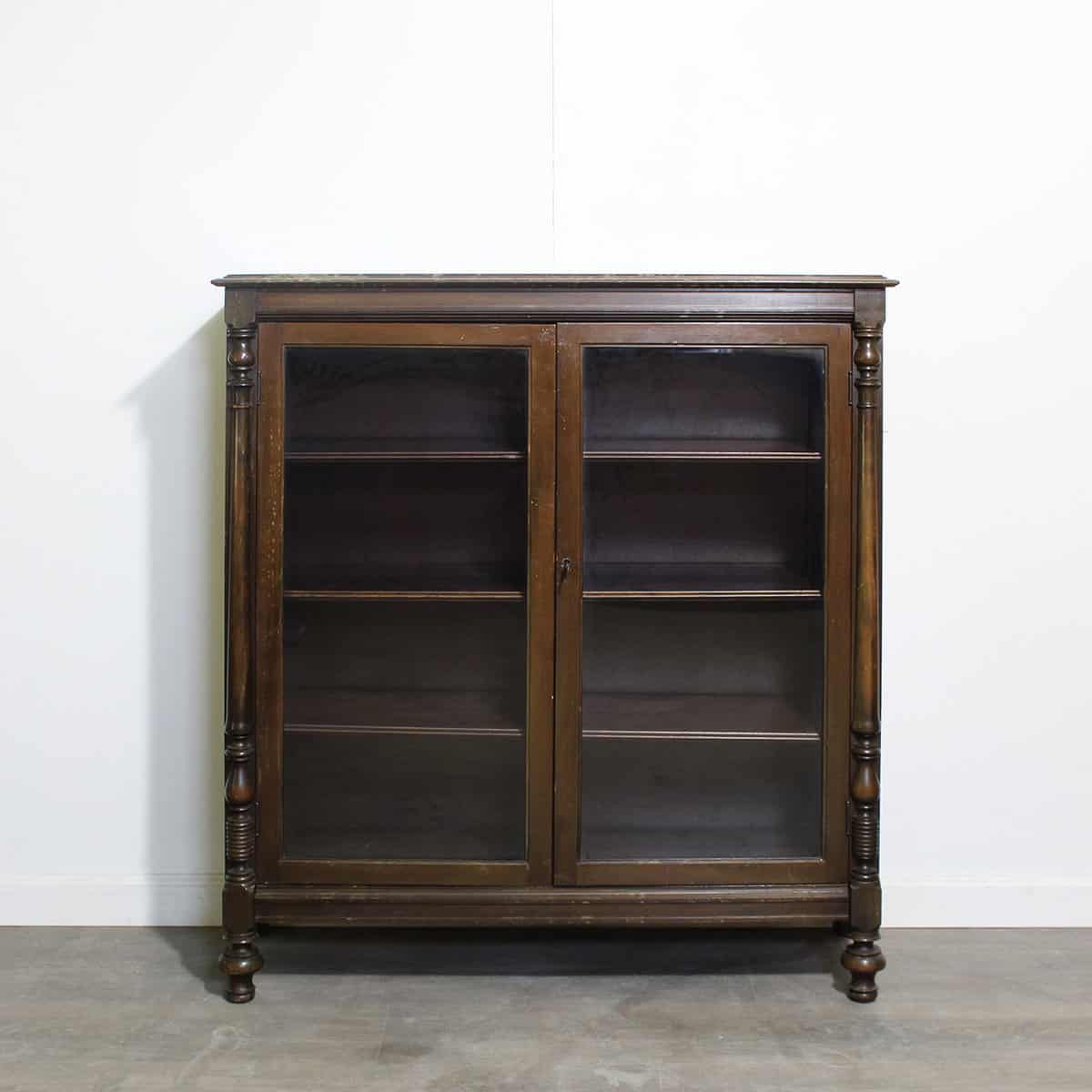
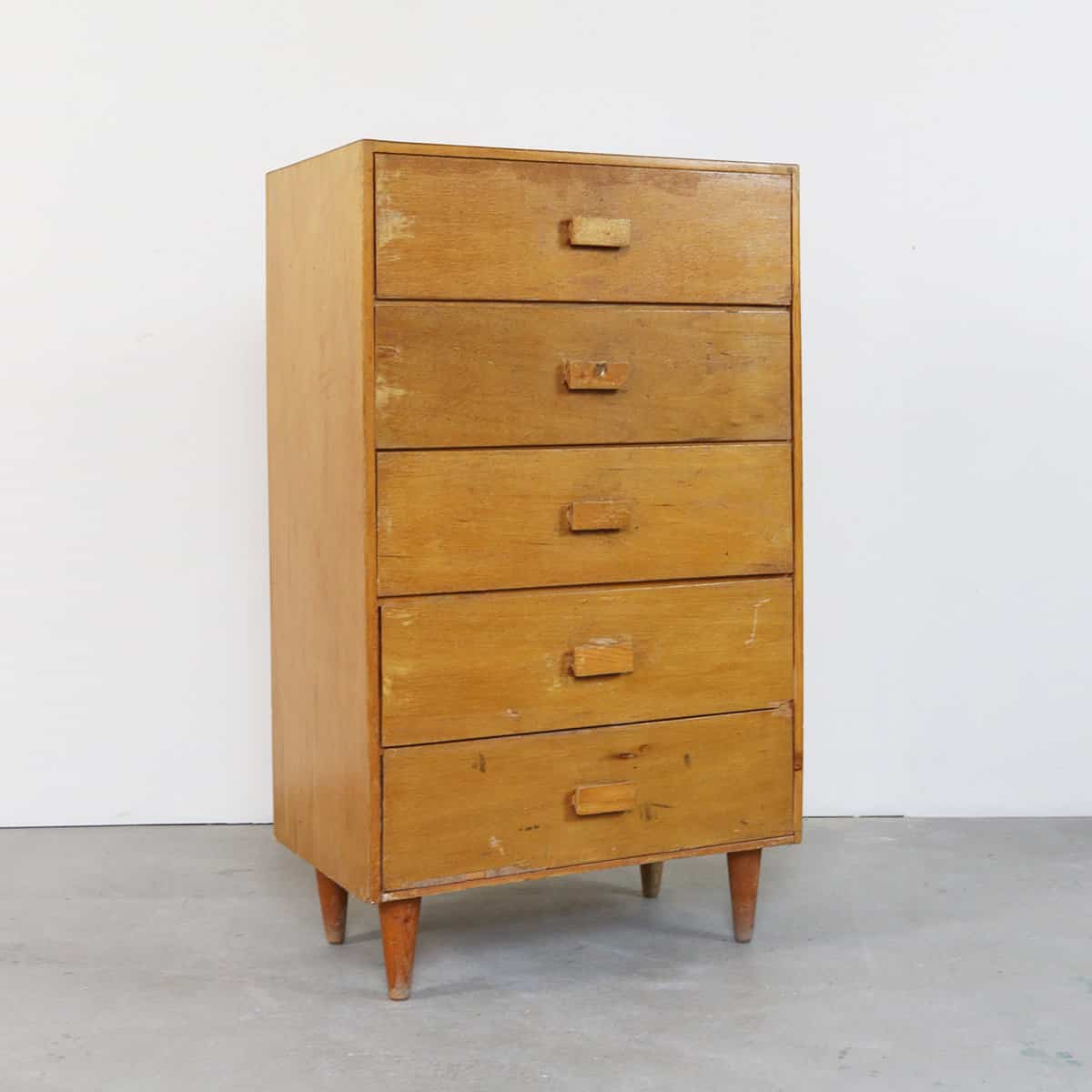
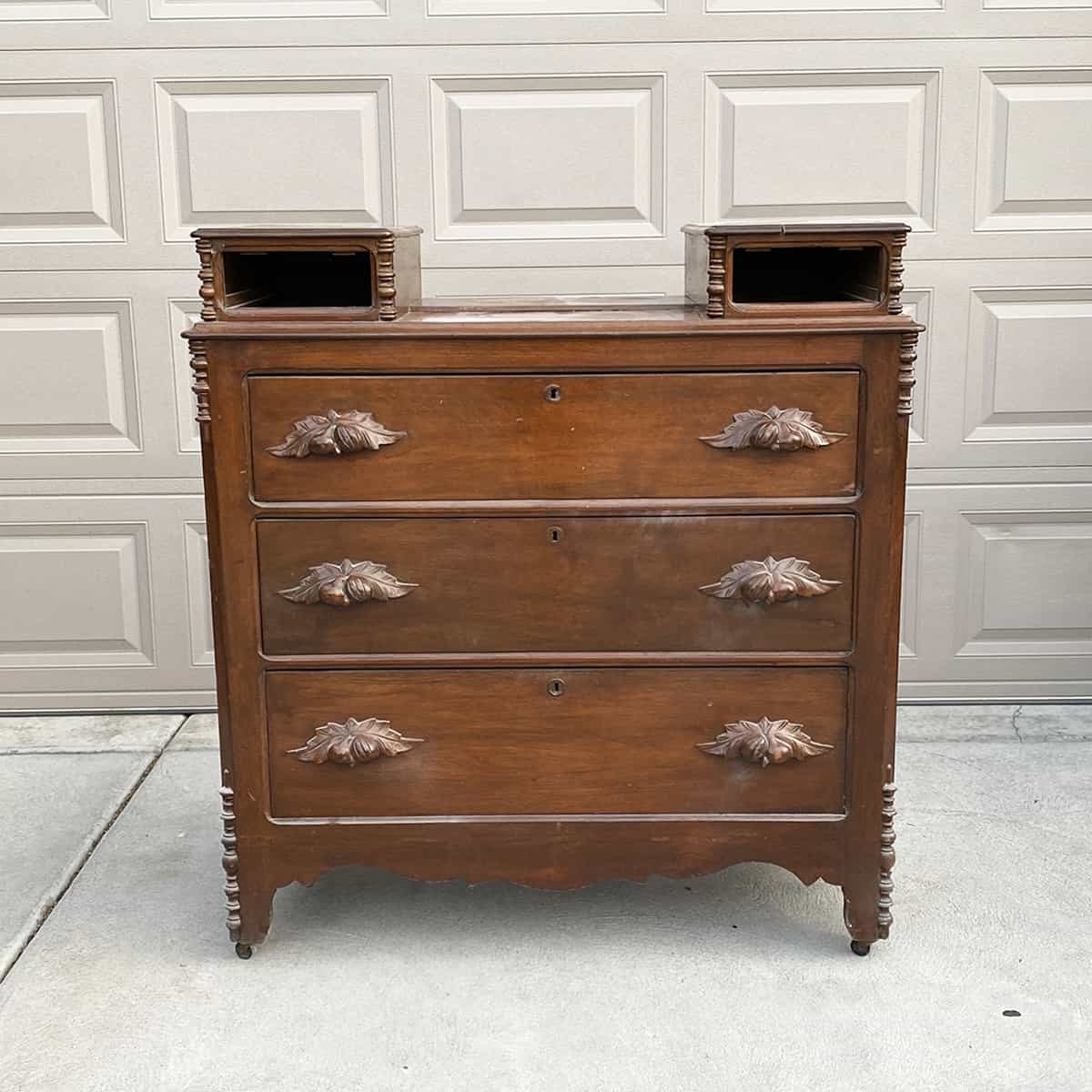
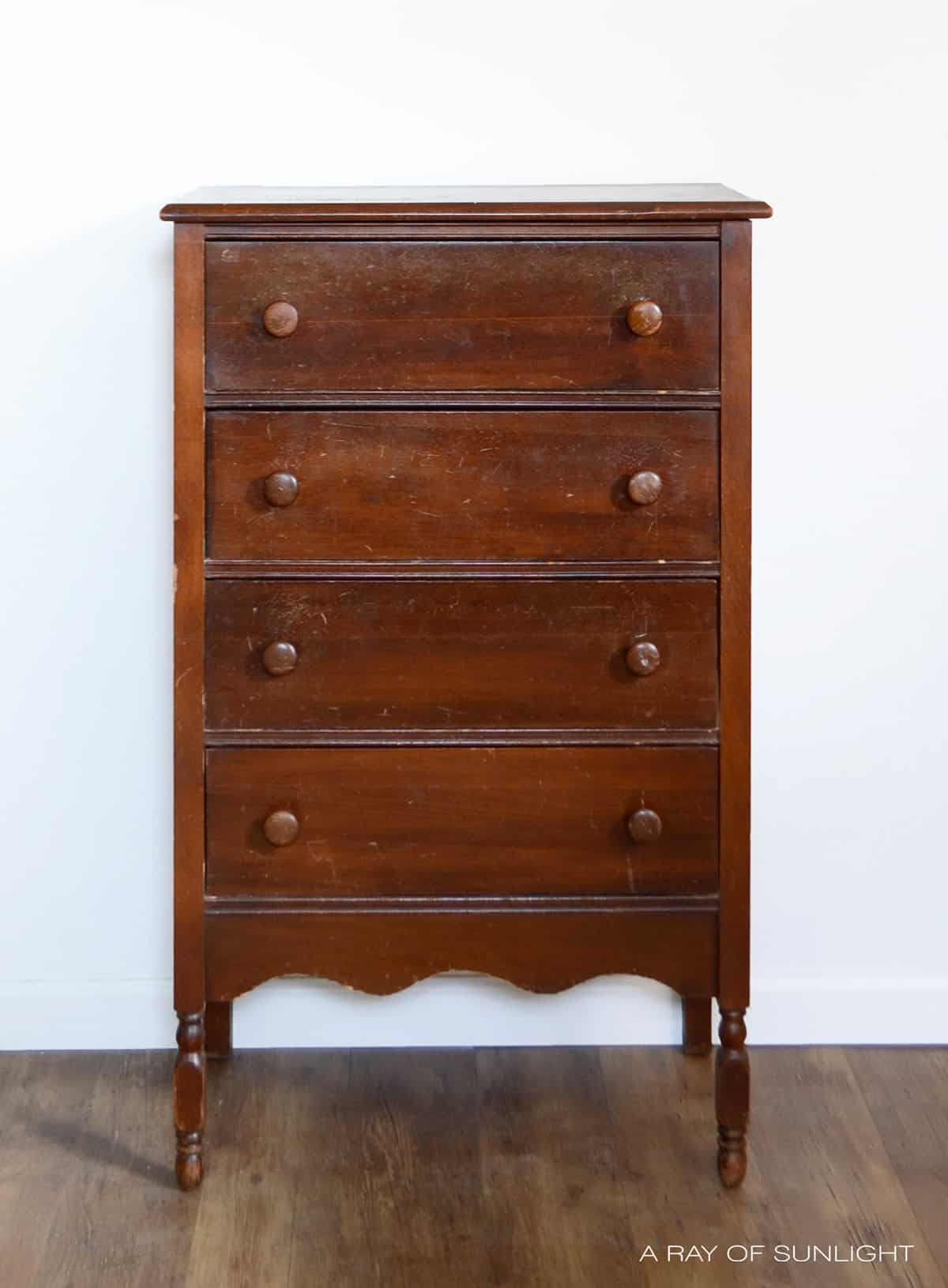
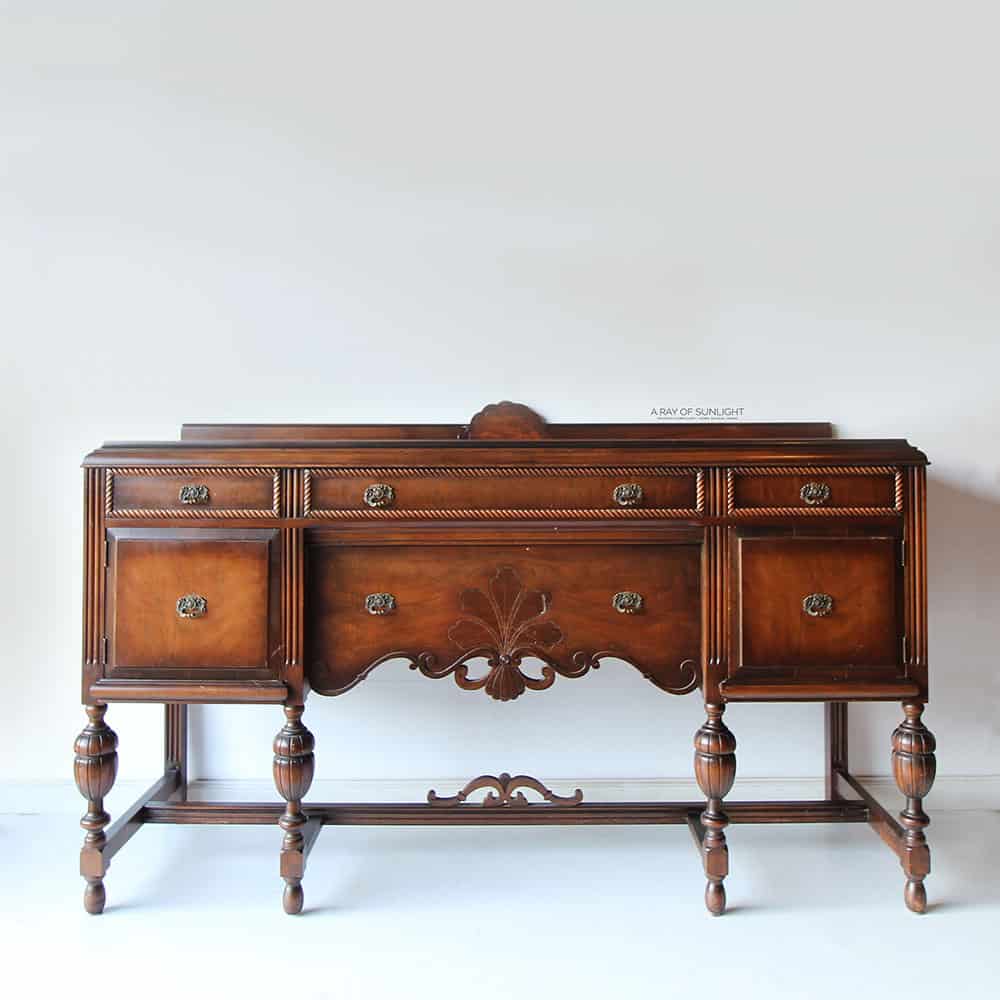
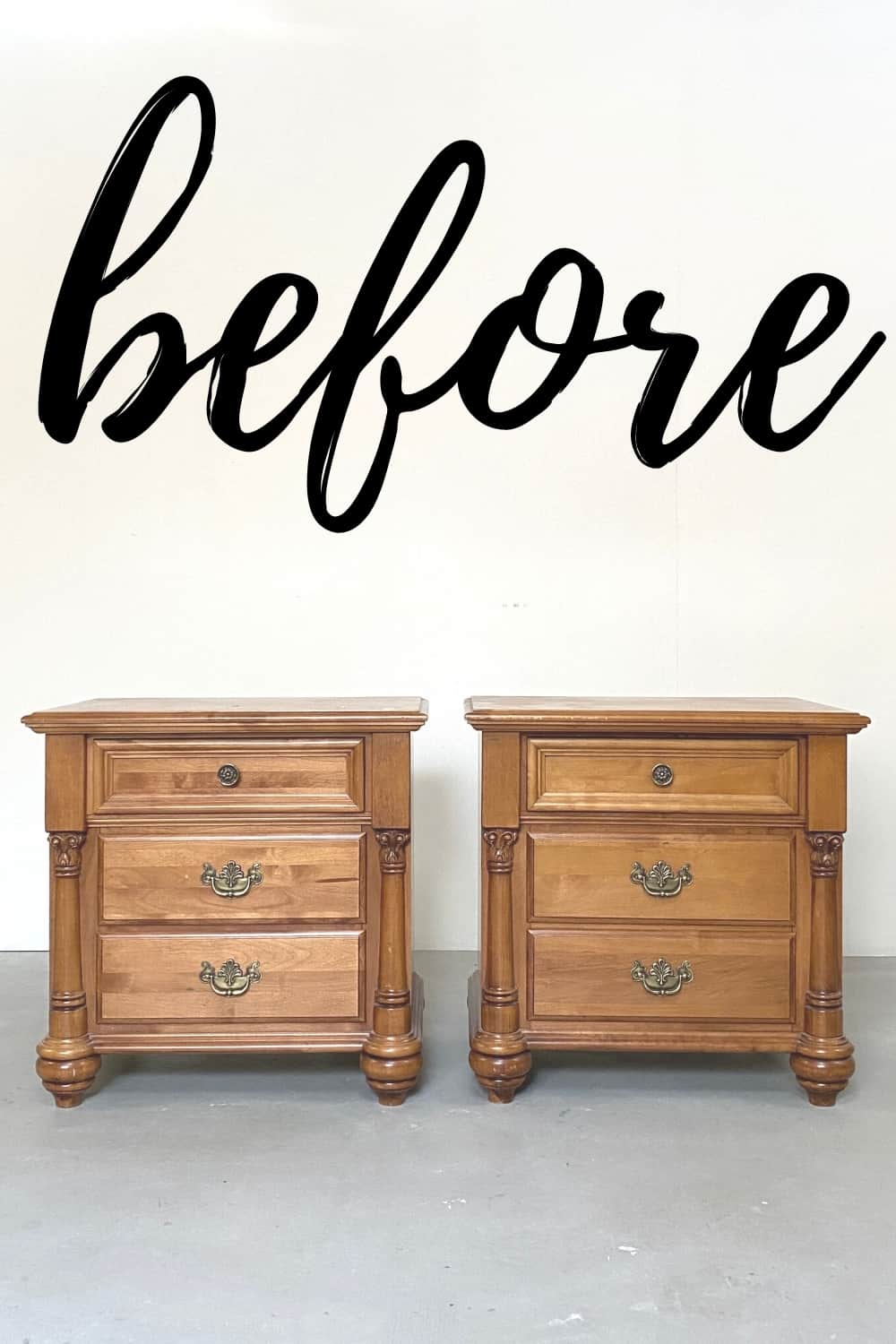
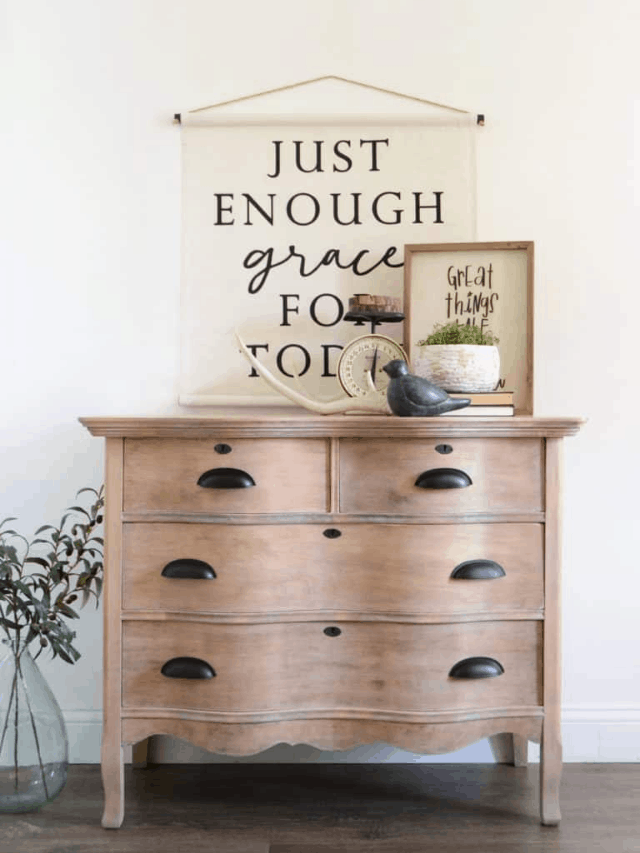



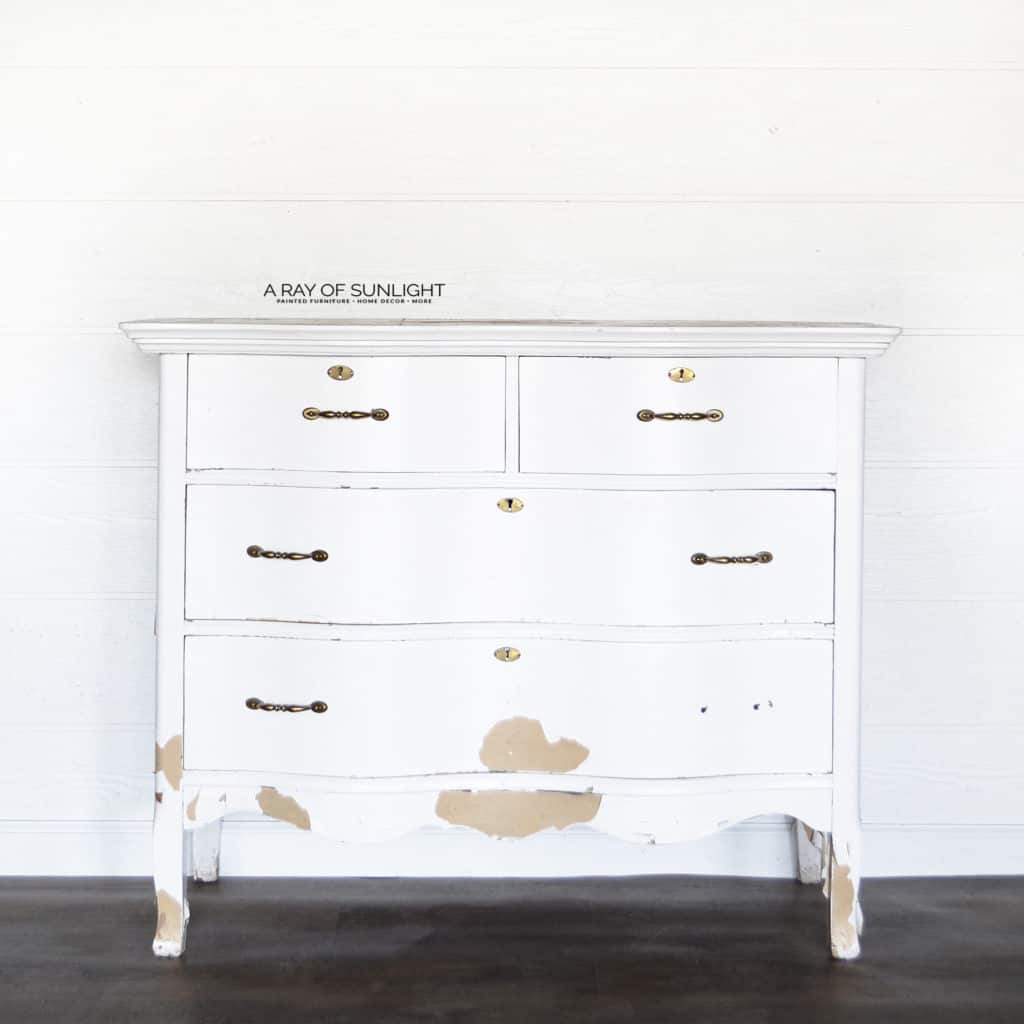
Hi! Your dresser looks amazing! Can you use this for a dining table as well, or does the sealant need to be something more? Thank you!
Hey Jillian!
For a dining table I would use oil based poly instead of water based. You’re going to need extra protection with all the wear and tear a kitchen table gets! General Finishes has some really good and durable oil based poly!
The most amazing is the final color of this dresser and raw wood look. If I use an oil based poly in a dining table isn’t it going to look yellow /orange over time? How can I achieve this great color? Would it also be better to avoid wax? Thanks!
Yeah, the oil based poly will definitely amber over time, compared to the water based poly.
You basically just need to decide if you want more durability or if you want the color to be right.
But yeah, for a dining table I would definitely avoid wax.
I’m trying to strip handrail on stairs
Love the look of this dresser! I am getting ready to redo a table. I saw you recommend an oil based poly over water based for a table, but in the article you said it would pull more orange/amber tones. Would you recommend mixing in more cream paint to offset this? Also, do you know what color and type of paint you mixed in? I”m scared I’ll get to the last step and use the wrong color and type of paint and mess it up! Thank you for this detailed post!
Hey Laura!
That’s such a good question! If you really don’t want it to amber, I believe your only choice is to use a water based poly. But I would make sure to use at least 4-5 coats of poly if you go with water based for a table. And then be more careful with it. I don’t think the cream paint would help offset the ambering at all, because the ambering would be on top of the cream paint. I honestly have no idea what exact paint I mixed into the wax, but it wasn’t anything super special. It might have been the color Heavy Cream in latex paint from home depot. But I’m not 100% sure.
Goodluck on your project!
Your articles are awesome! Thank you for sharing how to remove paint from old furniture!
Hi Natalie, loved your post! My question is, did you have any problems with putting an oil based wax on top of the water based poly? Does wax ever cause yellowing? Donna-Rei
Hey Donna! I haven’t had any problems in putting oil based wax over water based poly. If you’re worried about it, you can wait 48 hours after the poly completely dries to make sure you don’t have any issues. I’m not 100% sure if it does or doesn’t cause yellowing though.
Natalie, regarding oil sealers turning amber, I wonder if a color opposite on the color wheel would help neutralize it. Depending on just *how amber, possibly a violet or if more of an orange, a blue…..? It’s the kind of thing that you add a color in preparation for a sure thing – the future yellowing.
Your desire and effort to share your wealth of information in such detail is appreciated. Thank you.
Hey Linda! You might be onto something! Thank you for sharing!
I have a very large kitchen table that I refinished 6 years ago. Sealed it with 4 pr 5 oats of water based poly. The table is vigorously tested daily by our large family of eight. It is washed with dish soap and rinsed with water several times a day. It has held up beautifully! I thought I would need to light sand and re-coat occasionally, but no. Enough layers of water based poly will hold up to everyday use.
Can you skip the lead test and go ahead with the citristrip?
Yep! Just proceed as you would if it was lead based. Making sure to not sand it so dust gets in the air, etc.
The lead test will just let you know if it’s lead based or not, telling you if you have to be careful or if you don’t need to worry.
Hi, love this! Currently doing it to a console table. Question though… with the wax process afterwards… i thought one would have to re-wax it a year afterwards and so on. Is this true?
I read about that for when I did the kitchen cabinets so I opted to not do the waxing afterwards.
Hey Julia!
Yep, you’re right. I would never put wax on kitchen cabinets because of the heat and constant abuse they get. Furniture doesn’t get as much traffic and abuse, so you’re more safe to use wax on it, and it will last longer than on a kitchen.
If you don’t want to use wax, you can do a whitewash instead.
I am doing a dresser that is very close to this one. After stripping off the white paint, the drawer fronts look reddish. Maybe in the past someone finished it with a cherry stain? Is there any way to tone the red down? Do you think after lime waxing it tone down that red look?
Hey Jamie!
Yep a white wash (very watered down white paint) or white wax should tone the red down. Best of luck!
What about this technique on camper cabinets? I’ve been renovating one with wood cabinets with a wood varnish and now some of the varnish is starting g to come off. I didn’t want to paint them and love this type look.
Hey Ashley!
As long as the cabinets are wood, this technique will work!
Best of luck!
Natalie
I have a similar piece that I picked up recently and would like to refinish. It’s really beautiful and is at least 100. years old. Unfortunately the previous owner spray painted It with dark blue paint and then added a coat of poly. Would Citristrip work on spray paint? What would you recommend me using beforehand to remove the polyurethane? Thank you so much!
Hey Leslie!
Citristrip will remove the polyurethane and the spray paint. Just brush a thick layer of citristrip on it and let it go to work for you.
Best of luck!
I plan on stripping a similar old dresser that was painted probably in the 70’s or 80’s to make into a cottage bathroom vanity with a vessel sink on top. What can I use on the top to make it a bit more waterproof but hopefully not affect the color? (Hoping to keep it similar color to yours – like a natural wood/white wash/grey undertones)
Hey Kira!
Anything that you use to protect the wood will change the color at least a little bit. I would at least poly it and then you can add a white wash instead of wax to help lighten it up.
Best of luck!
Love how this dresser looks! How much citristrip does it take to cover a piece this size.? I’ve never stripped anything so was curious as to how much stripper to purchase. Thanks!
Hey Rhonda! I think I went through 1 or 2 of the 1/2 gallon size containers when all was said and done.
I had been saving your post for awhile and just decided to jump in with an old spindle style bed frame. Found 4 layers of paint and I am doing my second coating of Citristrip. My question is if I can overdo the number of times I apply the citristrip? Here in Colorado the air is SO dry that I found it had dried out overnight, even when covered with plastic. (I THINK the wood underneath might be mahogany so, I am super excited. ) I have a second layer brewing right now and laid the Citristrip on even thicker….
Hey Diane!
Nope I don’t believe that you can overdo how many times you use Citristrip, as long as there is still something to remove. Best of luck!
Hello! This is beautiful! Can it be done with laminate wood?
Hey Adriana!
I’m honestly not sure if you could do this on laminate. Sorry!